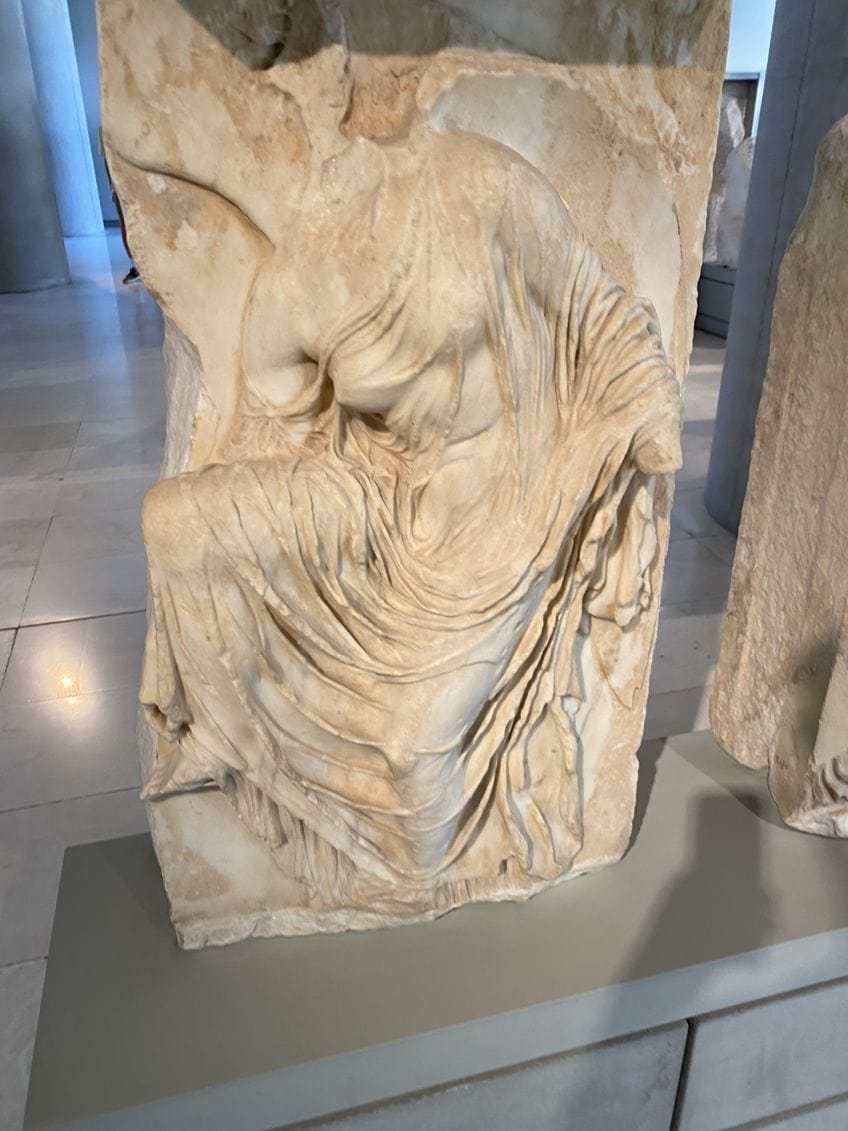Temple of Athena Nike – Exploring the Acropolis Temple
The Temple of Athena Nike is the smallest of the Acropolis temples. The Temple of Athena Nike was constructed in approximately 420 BCE and is the first entirely Ionic Acropolis temple. In Greek mythology, Nike was the deity of victory, and Athena was revered as this incarnation, representing great victory in battle. The people worshiped the gods in an attempt to win the arduous Peloponnesian War with the Spartans and their supporters.
Exploring the Temple of Athena Nike
| Architect | Callicrates (c. 470 – 420 BCE) |
| Date of Completion | c. 420 BCE |
| Function | Acropolis temple |
| Location | Acropolis of Athens, Athens, Greece |
The cult of Athena Nike was active in the early 6th century BCE. A cult figure of Athena sitting with a pomegranate in one hand and a helmet in the other was erected upon the remnants of a Mycenaean citadel. The Persians dismantled the Shrine of Athena Nike in around 480 BCE and replaced it with the Acropolis temple.

The History of the Temple of Athena Nike
The building of the new temple began about 449 BCE and was completed about 420 BCE. The sect was overseen by the Priestess of Athena Nike, who was chosen democratically. If it was still functioning by the 4th century, it would have been destroyed during the late Roman Empire’s repression of pagans. Greece remained under the sovereignty of the Byzantine Empire until 1453 when the Ottoman Empire seized Constantinople. The Temple of Athena Nike remained standing until it was razed in 1686 by the Ottomans, who utilized the rubble to fortify their walls.
Following Greece’s independence in 1834, the Acropolis temple was rebuilt.
The temple was disassembled in 1998 to rebuild the collapsing concrete floor, and its frieze was taken and relocated to the new Acropolis Museum, which opened in 2009. As construction progresses, the Temple of Athena Nike is regularly closed to tourists. The new museum display contains relics of the temple before it was believed to have been razed by the Persians in 480 BCE. Artworks from the friezes, including a statue of Moscophoros, a broken statue of a goddess attributed to Praxiteles, and a Rampin horseman, as well as inscribed decrees, dedications, and stelae, have been recovered.

The northern wall of the Temple of Athena Nike’s parapet portrays two Nikai erecting a trophy. This refers to Nike erecting trophies in Aristophanes’ Lysistrata, which was originally produced in 411 BCE. The pediment on the temple’s eastern end portrays a Gigantomachy, while the pediment on the temple’s western end represents an Amazonomachy. The acroteria on the temple’s eastern end portray Bellerophon riding with a herd of Pegasus on his way to defeat a Chimera.
The Architecture of the Acropolis Temple
The architect Callicrates erected it as a tetrastyle Ionic construction with a colonnaded portico on both the rear and front facades. The columns on the eastern and western sides were monolithic. The Temple of Athena Nike measured 8 meters in length, was 5.5 meters broad, and stood 7 meters tall. While the Acropolis temple was still standing, the overall height from the stylobate to the apex of the pediment was 7 meters. The height-to-diameter ratio of the columns is 7:1, instead of the more common 9:1 ratio found in Ionic structures.
It was erected in sections from white Pentelic marble when wartime resources allowed.
Friezes of the Acropolis Temple
The entablature’s friezes were embellished on all sides with relief sculptures in the typical classical manner of the 5th century BCE. The Temple of Athen Nike is oriented so that the eastern frieze rests above the structure’s entrance on the porch side. The northern frieze portrayed a cavalry fight between the Greeks. The southern frieze depicted the crucial victory against the Persians. The eastern frieze depicted a meeting of the gods Zeus, Athena, and Poseidon, illustrating how Athenian religious ideals and adoration for the deities were intertwined with the political and social atmosphere of 5th Century Athens. The original carving on the western frieze has been well-maintained.

It is most probably, like the eastern frieze, retelling the account of a war, or more especially, a triumph. There are several corpses represented as well as images of one ready to be murdered, with some characters wearing a helmet. This conflict between troops most likely depicts the Athenians’ slaughter of the Corinthians. Around 410 BCE, once the structure was finished, a parapet was built around it to deter visitors from plunging from the steep bastion. The parapet’s exterior was embellished with carved relief figures depicting Nike in a range of occupations, all in procession.
The temple was excavated in the 1830s by architects Eduard Schaubert and Christian Hansen.
The structure had been completely demolished in the 17th century, and the material had been incorporated into the Turkish wall that encircled the hill. When the Acropolis Temple was rebuilt from the remnants in 1836, a crude anastylosis was performed. In the summer of 2010, a third repair was finished. The basic construction, columns, and stylobate are mostly intact, with the exception of the roof and the majority of the tympanae. Pieces of the carved frieze are displayed at the British Museum and the Acropolis Museum, and replicas of these may be found in the temple.
The Parapet of Nike
A magnificent marble sculpture of a wingless Nike would have sat on the parapet. Nike’s right arm reaches towards her sandal, and her clothing is falling off her shoulder. For a long time, there was a great discussion over what the iconography in this monument was meant to symbolize. Many additional examples of sandal-related imagery may be seen on vases, cups, and even the Parthenon’s friezes. These variations, on the other hand, all show the protagonists leaning down with both arms held out to readjust or tie their sandals.

The disparity in iconography between one and two hands is what has produced confusion about the interpretation of the sculpture of Nike. Nike is most probably loosening or taking off her sandal rather than tightening or putting it on. This artwork is supposed to have been meant to illustrate the activity of removing sandals for those visiting the temple to pay homage to Athena, as this was a typical act of devotion in this place. Wet drapery may be observed in the iconic image of Nike removing her sandal.
Wet drapery entails revealing the shape of the body while also hiding it with the draping of the garment.
Some of the friezes date back to the Peloponnesian and Persian Wars. A cavalry scenario from the Battle of Marathon and a Greek triumph over the Persians were depicted on the friezes. Through military force and historical accounts, the conflicts illustrate Athenian and Greek domination. A sculpture of Nike was located in the cella, also known as a naos. The lack of wings on the Athena Nike statue caused Athenians in subsequent years to refer to it as Apteros Nike and the legend emerged that the sculpture was stripped of wings so that it would never depart.
Cornice and Cyma
The cornice, which lies directly above the frieze and extends around the whole edifice, follows conventional architectural designs. Many elements of the cornice excavated are thought to be part of the Temple of Athena Nike, however, other archaeologists feel that some of the fragments unearthed near the Acropolis temple may not be. These cornice pieces are lined on the interior with a series of perforations, lending credence to the theory that the cornice was kept in position by dowels that joined it to the frieze.

Several of these cornice pieces have been weathered and deteriorated to the point that the dowel holes can no longer be seen. The cornice spreads flat with no moldings to form a pattern. It would not have been sculptural if there was a design. There are indications that the cornice was decorated at some point in the past. Yet, because the architecture has been weathered for so long, all interpretation of the design has long been erased.
The cyma is located on the northern and southern sides of the Acropolis temple, directly above the cornice.
They are angled on both sides, forming the slope that forms the pediment and roofing. An arrangement of lion heads that extends outward runs along the cyma. There are openings slightly above the cyma at either end of the cyma, where the sides would have turned into the temple’s eastern and western faces, where an akroteria would have been erected.
Akroteria
The primary body of the akroteria’s center sculpture was fashioned of bronze rather than marble. There is gilded foiling and gold wire visible through the primary bronze core. Researchers postulated about the statue’s shape, but there is no remnant of the initial sculpture to show what the center acroteria looked like. The same holds true for the sculptures that would comprise the eastern and western akroteria. Both were fashioned of bronze, and it is hard to say what the characters were. Theories about the center statue’s figure include a Pegasus rearing or a Chimera.

A bronze tripod, similar to those found on the Temple of Zeus at Olympia, is one probable explanation for the center akroteria. This theory has not been debunked for several reasons:
- The measurements of the tripod would fit in the slots of the supporting block, making it a reasonable choice for the statue’s design.
- When functioning as an akroteria, a tripod would likely have a bronze core.
- The Tripod was a popular emblem of triumph. Another possibility for the center akroteria that has yet to be debunked for a number of the same factors as the tripod is that it was a memorial trophy.
The temple of Athena Nike is the smallest temple on the Acropolis in Athens, located on the brink of a steep cliff in the southwest corner. It was finished around 420 BCE, during the High Classical Period, using the designs of Callicrates, the same designer who was involved in the Parthenon’s construction. The Callicrates Acropolis temple replaced an earlier temple that was razed during the Persian wars.
Frequently Asked Questions
What Was the Temple of Athena Nike Used For?
The temple of Athena Nike, like many other Greek buildings, was considered the residence of the goddess, symbolized in its sculpture, and was not open to the public. Followers would perform ceremonies at the front of the building, where a little altar was set up, and get a sight of the deity’s carved body through the gap between the columns. The priestesses, who had a recognized standing in Greek society, had the right of accessing the temple.
Who Was the Temple of Athena Nike Constructed For?
The temple contained the statue of Athena Nike, a symbol of triumph. It was most likely related to the Greek triumph over the Persians roughly a half-century earlier. Nike was known to have wings, but in this case, we know that the sculpture lacked them, thus the name Athena Apteros.
Justin van Huyssteen is a freelance writer, novelist, and academic originally from Cape Town, South Africa. At present, he has a bachelor’s degree in English and literary theory and an honor’s degree in literary theory. He is currently working towards his master’s degree in literary theory with a focus on animal studies, critical theory, and semiotics within literature. As a novelist and freelancer, he often writes under the pen name L.C. Lupus.
Justin’s preferred literary movements include modern and postmodern literature with literary fiction and genre fiction like sci-fi, post-apocalyptic, and horror being of particular interest. His academia extends to his interest in prose and narratology. He enjoys analyzing a variety of mediums through a literary lens, such as graphic novels, film, and video games.
Justin is working for artincontext.org as an author and content writer since 2022. He is responsible for all blog posts about architecture, literature and poetry.
Learn more about Justin van Huyssteen and the Art in Context Team.
Cite this Article
Justin, van Huyssteen, “Temple of Athena Nike – Exploring the Acropolis Temple.” Art in Context. January 12, 2023. URL: https://artincontext.org/temple-of-athena-nike/
van Huyssteen, J. (2023, 12 January). Temple of Athena Nike – Exploring the Acropolis Temple. Art in Context. https://artincontext.org/temple-of-athena-nike/
van Huyssteen, Justin. “Temple of Athena Nike – Exploring the Acropolis Temple.” Art in Context, January 12, 2023. https://artincontext.org/temple-of-athena-nike/.








